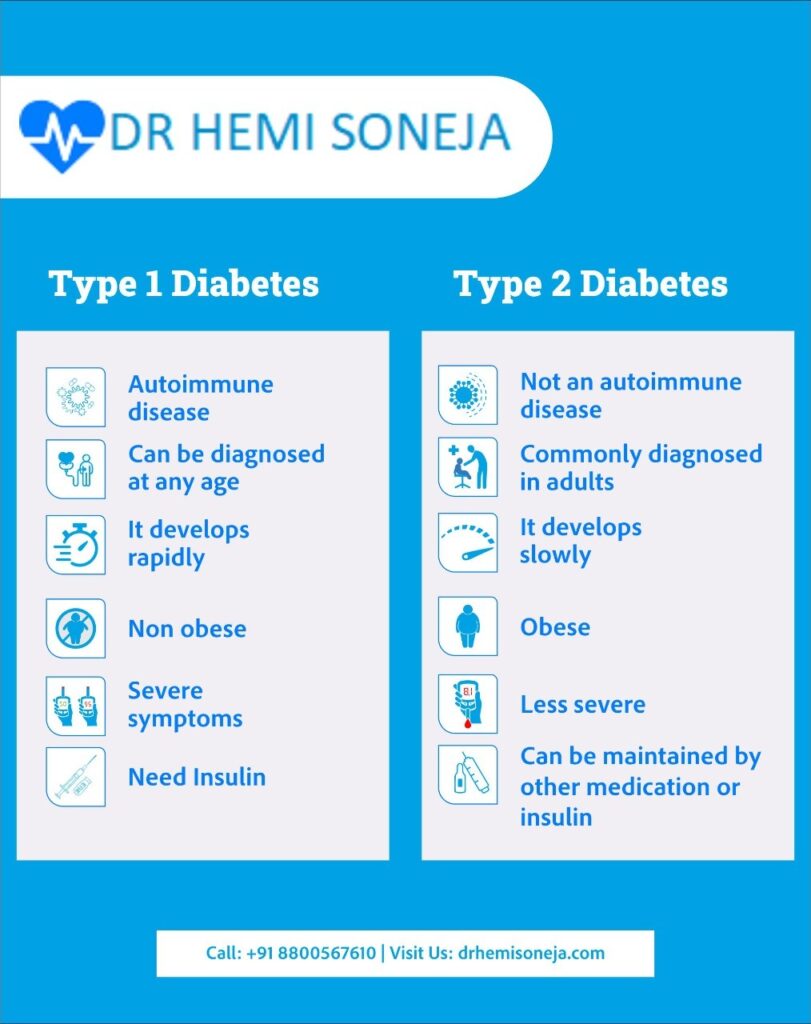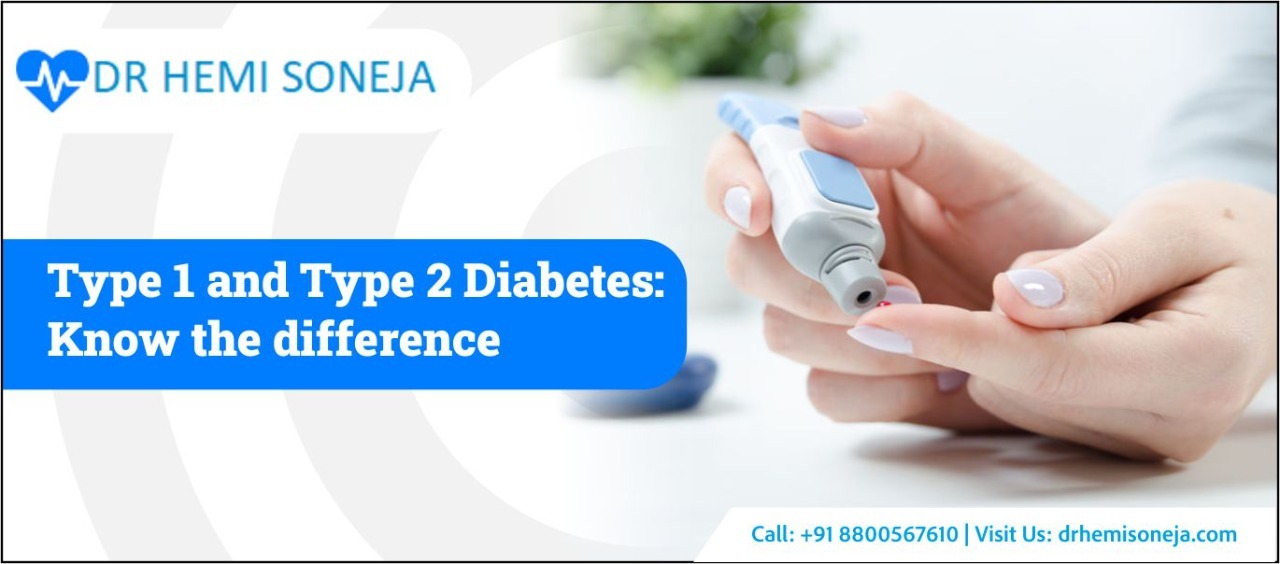Diabetes is a metabolic disorder- a condition in which our bodies fail to use digested food properly for growth and energy. Type 1, type 2, and gestational(during pregnancy) diabetes are the three main types of diabetes. Diabetes is characterized by increased blood sugar levels because insulin (the hormone produced by pancreas responsible for regulating blood sugar) cannot be produced or used by the body effectively. Children and adolescents are most common to suffer from Type 1 diabetes, although adults can also experience it. Approximately 5-10% of people with diabetes have Type 1 diabetes. In 90-95 percent of cases, people with diabetes have Type 2 diabetes. People over the age of 45 are most likely to develop type 2 diabetes, but children, teenagers, and young adults are also becoming more prone to the disease. The good news is that a healthy lifestyle and an effective medication plan can manage diabetes to a great extent. The following blog will help you understand the difference between type 1 and 2 diabetes. Diabetologists in Delhi can provide efficient diabetic care plans to diabetics of all types.
1. Difference between type 1 and 2 diabetes
Globally, there were 387 million diabetics in 2014, and that number will increase to 592 million by 2035.
Types of diabetes:
- Diabetes type 1
- It is a condition that occurs when the body stops making insulin as a result of an autoimmune response. Also called insulin-dependent diabetes.
- In this case, the body accidentally attacks itself, it destroys the beta cells in the pancreas that make insulin.
- Neither diet nor lifestyle factors cause type 1 diabetes.
- There is no way to prevent it.
- Diabetes type 2
- It is prevalent in patients with insulin resistance. Also called non-insulin-dependent diabetes.
- A hormone secreted by your pancreas called insulin plays a key role in allowing blood sugar to enter your cells and be used as fuel.
- People with type 2 diabetes develop insulin resistance when their cells do not react to insulin appropriately.
- A person’s pancreas produces more insulin in response to their cells’ response.
- Over time, your pancreas cannot handle the increasing blood sugar levels, resulting in type 2 diabetes and prediabetes.
Sugar remains in the blood in both types of diabetes instead of being used by the body, causing various health problems.
Symptoms
- It usually takes several weeks for type 1 diabetes symptoms to develop. This type is typically diagnosed during childhood or adolescence and was formerly known as juvenile diabetes. Nonetheless, type 1 diabetes can come on later in life as well. Diabetes type 1 is characterized by severe symptoms that often occur suddenly:
- An increase in thirst
- An increase in hunger (especially after eating)
- You have a dry mouth
- Increase in frequency of urination
- You seem to be losing weight even though you eat and feel hungry.
- Fatigue (a feeling of weakness and exhaustion)
- A blurry vision
The symptoms of type 2 diabetes can develop very slowly, and they may not appear for many years. Individuals with type 2 diabetes often exhibit no symptoms and are not aware of having the disease until complications arise.
- Risk factors: When left uncontrolled, diabetes can cause a host of complications that can affect almost every organ in the body.
Type 1 DM
- Possibly, exposure to some infections or viruses, such as mumps or rubella cytomegalovirus.
- A person with certain diseases, such as cystic fibrosis or hemochromatosis, may suffer from a type of diabetes that is similar to type 1 diabetes.
Type 2 DM
- There are many risk factors associated with type 2 diabetes, such as having a family member who has the disease
- Having clinical conditions like, polycystic ovary syndrome (PCOS), prediabetes, obesity, and being over 45 years of age, lack of physical activity etc.,
- The use of some medications, including some medications for HIV and chronic steroids.
Treatment and management
Diabetes can be managed and controlled, but it cannot be cured. The objectives of diabetes management are to:
- As much as possible, maintain steady blood sugar levels by balancing your diet and medications.
- By avoiding added sugars and processed starch and reducing saturated fat and cholesterol, you can maintain your cholesterol and triglyceride (lipid) levels at or near their normal levels.
- You should maintain blood pressure below 130/80.
- Diabetes-related health problems can be prevented or slowed down.

2. Testing for diabetes
Diabetes type 1 or type 2 can be diagnosed with the tests listed below. But not all of them are useful for both:
- A1C test:: A1C tests involve taking a blood sample that indicates a person’s average blood sugar levels over the past three to six months.
- Fasting plasma glucose (FPG) test: A fasting blood glucose test helps measure a person’s blood glucose levels.
- Oral glucose tolerance test (OGTT): A person’s glucose metabolism is measured with this test. Before and after consuming sugary drinks, the patient needs to take a blood glucose test.
- Random plasma glucose (RPG) test: An RPG test helps determine a patient’s blood glucose level at any time throughout the day. It isn’t necessary to fast before undergoing this test.
The patient may get a diagnosis of diabetic or prediabetic conditions based on the results.
What should my blood sugar be when I wake up (fasting) and before meals? What about after?
- A target fasting blood glucose level of 70–130 mg/dl is ideal for most people with diabetes. Blood sugar levels between 180 mg/dl and 190 mg/dl should be measured one to two hours after eating.
3. Living with diabetes
By adopting simple changes, diabetes can be managed better as a normal condition. Patients with diabetes are advised by their physician or dietician about Diabetes Self-Management Education and Support (DSMES) services to help them manage their condition.
- Eat right: In order to live well with diabetes, managing blood sugar, and eating well is critical.
- A healthy eating plan can be created with the help of your dietitian or diabetes educator.
- Alongside healthy eating, weight maintenance is equally important. A BMI of 25 or less and a waist circumference of 35 or less will give you a good idea about your weight.
- You can manage your diabetes better if you are physically active, making your body more sensitive to insulin (which allows your cells to utilize blood sugar). In addition to lowering blood sugar levels and heart disease risks, physical activity also helps control blood sugar levels.
- To prevent or delay long-term, serious health issues such as heart disease, kidney disease, and vision loss, it is important to keep your blood sugar levels in your target range as much as possible.
4. FAQ’s
Which type of diabetes is worse?
The symptoms of type 2 diabetes are often milder than those of type 1. However, it can still cause serious health complications, particularly in the blood vessels of the kidneys, nerves, and eyes. You are also more likely to suffer a heart attack or stroke if you have type 2.
When I have diabetes, what foods should I eat?
Knowing what to eat on your plate and what portion size to consume is important. You can learn how to count carbohydrates and develop meal plans customized specifically for you by a dietitian.
Does a diagnosis of type 2 diabetes mean I will have to go on insulin?
- It depends on several factors, including the timing of diagnosis, whether people with type 2 diabetes will ever need insulin injections. Diabetes type 2 can be effectively and efficiently controlled by controlling blood sugar early on and over time, as the pancreas is more likely to produce enough insulin. People living with type 2 for 15 years or more may not be able to produce enough insulin on their own. They will need insulin in their medication.
Can I get rid of type 2 diabetes if I stop eating carbs and lose a lot of weight?
- There’s no cure for diabetes, but you can control it. If you have prediabetes or just were diagnosed with type 2, losing weight will put the condition under control. Regaining weight, getting older, and the natural progression of type 2 diabetes can turn it back.
Can exercise cure Diabetes?
Diabetes cannot be cured with exercise, but exercise can help maintain blood glucose levels. However, people with type 1 DM associated autonomic neuropathies should avoid exercising. Despite early cardiac autonomic neuropathy in type 1DM, even low-intensity exercise like yoga can increase heart rate variability.
Take Away
People can manage their diabetes at home, but diabetes is not curable. A tailored medication and nutrition plan tailored to your individual concerns is often necessary to live with diabetes happily. At Hemi Soneja Clinic, you will get the right suggestions and care according to your concern. With the help of experienced doctors and diabetic educators, our diabetes management team provides the best diabetic care plans and prevents future complications.



